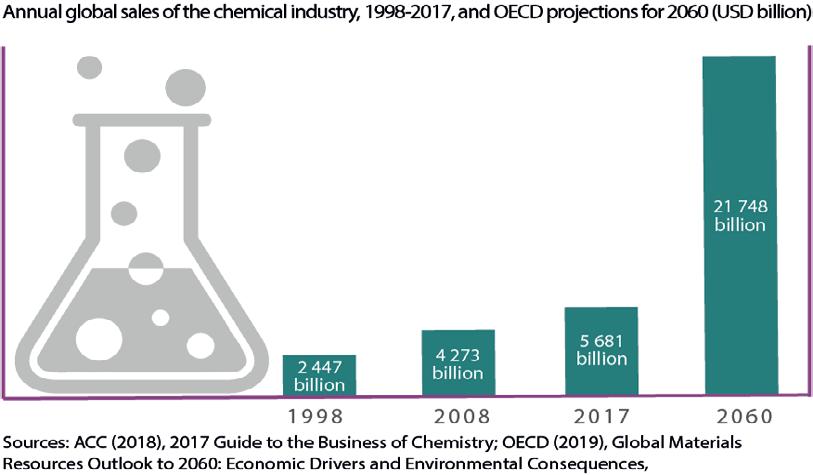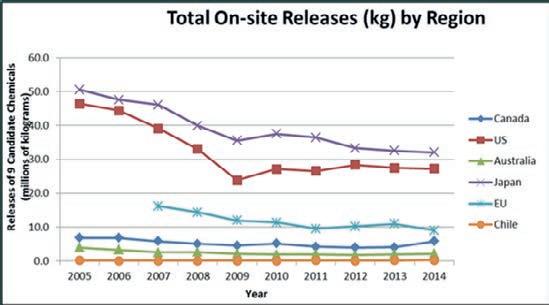
24 minute read
1. Benefi ts of the sound management of chemicals
Overview of the chemical industry
Modern life without chemicals would be inconceivable; chemicals are part of our daily life.


DID YOU KNOW?
The chemical industry is one of the world’s largest, with sales worth more than EUR 4 000 billion annually and is expected to grow to almost EUR 24 000 billion by 2060.

Benefi ts of the sound chemicals management
The ultimate benefi t of the sound management of chemicals is achieving that they are produced and used throughout their life-cycle in ways that lead to the minimisation of adverse eff ects on human health and the environment.
Therefore, the sound management of chemicals includes:
l prevention (i.e. application of the precautionary approach), l remediation (e.g. application of the polluter-pays principle), l minimisation and elimination of risks (e.g. application of the pollution prevention principle) during the life cycle of chemicals (production, storage, transport, use and disposal). It involves also the use of the best available scientifi c information and assessment; the internalisation of environmental and human health costs as well as the implementation of the right-to-know principle by providing the public with information on the releases and properties of chemicals .
The sound management of chemicals provides many tangible benefi ts for the general public and supports the protection of the environment.
Helps achieve the

The sound management of chemicals contributes to achieving a number of specific targets of the Sustainable Development Goals:
Ensure healthy lives and promote well-being for all at all ages
l Target 3.9 Reduce the number of deaths and illnesses from hazardous chemicals and air, water, and soil pollution and contamination
Make cities inclusive, safe, resilient and sustainable l Target 11.6 – Reduce cities’ environmental impacts
Ensure access to water and sanitation for all
l Target 6.3 - Improve water quality by reducing pollution, eliminating dumping and minimising release of hazardous chemicals and materials, halving the proportion of untreated wastewater and substantially increasing recycling and safe reuse globally
Build resilient infrastructure, promote sustainable industrialisation and foster innovation l Target 9.4 - Make infrastructure and industries sustainable
Ensure sustainable consumption and production patterns l Target 12.4 – Achieve environmentally sound management of chemicals and all wastes
The sound management of chemicals helps implementing Multilateral Environmental Agreements on chemicals
The Sound Management of Chemicals helps governments to be in compliance with international obligations and recommendations.
2013
Minamata Convention on Mercury
2001
Stockholm Convention on Persistent Organic Pollutants (POPs)
1998


Rotterdam Convention on the Prior Informed Consent Procedure for Certain Hazardous Chemicals and Pesticides in International Trade
1987
Montreal Protocol on Substances that Deplete the Ozone Layer
1985


Vienna Convention for the Protection of the Ozone Layer




Supports an integrated approach to assessing and reducing risks from chemicals
Sound chemicals management allows addressing new and existing chemicals in a comprehensive manner and ensures that information on chemicals is available for governments to support the identifi cation of possible risks to human health and the environment. It also promotes the prevention of pollution at source.
Sound chemicals management supports the establishment of multi-institutional co-ordination and co-operation mechanisms, necessary to appropriately develop and implement the sound chemicals management throughout their life-cycle, as it usually requires the involvement of authorities responsible for instance for the environment, health, labour, trade, foreign aff airs and consumers.
Sound chemicals management enables to evaluate countries’ environmental policies as well as to measure and promote improved environmental performance of industrial activities. In this respect, the use of information obtained through the Pollutant Release and Transfer Registers is of great importance.
The OECD is exploring how PRTR data can be used to conduct global-scale analyses, and specifi cally to evaluate, and potentially even accelerate, progress towards meeting relevant SDG targets.
The fi gure below shows how on-site releases changed over the years for 9 representative chemicals for a number of PRTRs. Trends show that releases mostly decreased. Source: US Environment Protection Agency (2017); OECD, Tracking SDGs with PRTRs – Progress and challenges, (2017)

Link: https://oe.cd/prtr-databases
Reduces the cost of inaction
Prevention is an essential element of sound management of chemicals. By taking preventive actions to minimise the adverse eff ects of chemicals on human health and the environment (and therefore reducing for instance the number of accidents at work or unintentional poisonings) as well as by reducing the likelihood of the occurrence of chemical accidents, governments reduce the costs of public spending related to healthcare and response to accidents. or unintentional poisonings) as well as by reducing the likelihood of the occurrence of chemical accidents, governments reduce the costs of public spending related to healthcare and response to accidents.
The UNEP Costs of Inaction report assessed the total health care costs associated with pesticides. It concluded to a direct relationship between volumes of pesticides used and health effects and estimated the accumulated costs of inaction to the sub-Saharan Africa region to USD 97 billion for 2005-2020. However, as pesticides imports and use volumes increase, costs could reasonably be assumed to become proportionally higher; the chemicals management challenge will become bigger in terms of volumes that need to be managed safely throughout the chemical lifecycle in an agricultural sector dominated by dispersed, small and financially-challenged farming operations. Source: UNEP, Costs of Inaction on the Sound Management of Chemicals (2013) http://drustage.unep.org/chemicalsandwaste/sites/unep. org.chemicalsandwaste/fi les/publications/Costs_of_ Inaction.pdf
Australia - Financial benefi ts from the environmental risk management of industrial chemicals Under an on-going reform, Australia has examined options to implement a nationally consistent approach to the environmental risk management of industrial chemicals. It was found, inter alia, that such action would result (over a 10-year period) in: • Reduced remediation costs in a range between 46 and 92 million AUS dollars; • Reduced public health exposure costs in a range between 52 and 172 million AUS dollars.
Source: Australian Government Department of the Environment (2015), “Environmental Risk Management of Industrial Chemicals, Decision Regulation Impact Statement”, http://ris.pmc.gov. au/2015/12/16/national-standard-environmental-risk-managementindustrial-chemicals (accessed 1 March 2018).
Helps to adapt to new emerging challenges
The sound management of chemicals requires the development and establishment of an appropriate regulatory and institutional framework as well as securing the necessary human, technical and fi nancial resources for its long-term implementation.
Once these elements are in place, they enable governments to easily adapt this framework to address new and emerging challenges, like for instance manufactured nanomaterials or endocrine disrupting chemicals.
Adapting to the new challenges stemming from nanomaterials

The existing international (e.g. the OECD legal instruments on chemicals) and national chemical regulatory frameworks or other management systems e.g. in Canada (Canadian Environmental Protection Act 1999); the United States (Toxic Substances Control Act) or the European Union (the REACH and CLP Regulations), developed with respect to the sound management of chemicals, proved to be fl exible enough to address nanomaterials, when they are adapted to take into account the specifi c properties of manufactured nanomaterials.
Enhances governments’ reputation for eff ective, predictable chemicals management
The general public is more and more concerned with the safe use of chemicals. And at the same time it recognises and expects governments action in this area.
Safe use of chemicals – general public perception and expectations in the European Union
In a survey published in 2011 a vast majority of the EU respondents characterised chemicals as dangerous or harmful to the environment (68% and 63% respectively) and over a half as unhealthy. In a similar survey published in 2017, 65% expressed concern about their exposure to hazardous chemicals. On the other hand, almost a half of the EU respondents (44%) declared in 2017 that the chemical substances on the EU market are safer than they were 10- 15 years before and only 16% declared they are less safe, which means that the governments responsible for enacting actions in this area deserve credit. Sources: European Commission (2011), “Special Eurobarometer 360 Consumer understanding of labels and the safe use of chemicals”, http://ec.europa.eu/public_opinion/ archives/eb_special_379_360_en.htm (accessed 1 March 2018). European Commission (2017), “Special Eurobarometer 456 Chemical Safety”, http://ec.europa.eu/commfrontoffi ce/publicopinion/index.cfm/ResultDoc/download/ DocumentKy/78785 (accessed 1 March 2018).
11 . BENEFITS FROM IMPLEMENTING A CHEMICAL MANAGEMENT SYSTEM © OECD 2019
Increases productivity
For industry to publish the relevant data on hazardous properties of chemicals it uses and to perform their risk assessment is benefi cial in several ways.
These data are needed for regulatory purposes but also ensure communication in the supply chain on the safe use of chemicals. In particular, it enables preparing safety data sheets that include the information relevant for the occupational safety and health (e.g. fi rstaid measures, fi re fi ghting measures, accidental release measures, safe handling measures, personal protection measures).
The use of this information leads to improved protection of workers and therefore reduces the number of accidents and the occurrence of occupational diseases. As a result, a healthier population is more productive and generates wealth.
Loss of productivity due to pesticides use. In Mali, the chronic loss of productivity due to pesticides use is estimated to cost 50% of the annual agricultural GDP per habitant.
Source: Ajayi, O., Camara, M., Fleischer, G., Haidara, F., Sow, M., Traoré, A., and van der Valk, H. (2002). Socio-economic assessment of pesticide use in Mali. Pesticide Policy Project Special Issue no. 6, GTZ/ University of Hannover, Germany. Available at: http://www.ifgb.uni-hannover.de/2699.html

In 2005 the US Liberty Mutual Insurance Group surveyed 231 chief fi nancial offi cers of large and mid-sized companies. They reported that increased productivity is the number one benefi t of an eff ective workplace safety programme (42.5% rated productivity most important, with 28.3% of CFOs feeling cost reductions were the biggest benefi t followed by employee retention and employee morale at 7.1% and 5.8%). In its 2017 Workplace Safety Index, Liberty Mutual estimated that employers paid more than $1 billion per week for direct workers’ compensation costs for disabling, non-fatal workplace injuries in 2014. Employers that implement eff ective safety and health management systems may expect to signifi cantly reduce injuries and illnesses and reduce the costs associated with these injuries and illnesses, including workers’ compensation payments, medical expenses, and lost productivity. In addition, employers often fi nd that process and other changes made to improve workplace safety and health may result in signifi cant improvements to their organisation’s productivity and profi tability. Sources: Smart, S., Stearns, M., “White Paper: Safety Saves Dollars…And Makes Sense”, https://www.grainger.com/content/white-paper-safety-saves-dollars-andmakes-sense (accessed on 14 December 2017); US Occupational Safety and Health Administration webpage, “Business Case for Safety and Health”, https://www.osha. gov/dcsp/products/topics/businesscase/index.html, (accessed on 14 December 2017).
Gains of effi ciencies, resource savings and reduced costs for compliance
Apart from the savings related to the reduced number of accidents and occupational diseases, the sound chemicals management enables industry to: l identify improvements in the process safety; l fi nd reductions in insurance and maintenance costs l prevent business risks related to liability claims.
The benefi ts of the Globally Harmonised System (GHS)
GHS stands for the Globally Harmonized System of Classifi cation and Labelling of Chemicals. This system addresses classifi cation of chemicals by types of hazard and proposes harmonized hazard communication elements, including labels and safety data sheets. It aims at ensuring that information on physical hazards and toxicity from chemicals is available in order to enhance the protection of human health and the environment during the handling, transport and use of these chemicals.

The US Occupational Safety and Health Administration (OSHA) anticipates that, inter alia, the GHS implementation will: l facilitate international trade in chemicals whose hazards have been identifi ed on an international basis; l increase effi ciency and reduce costs from compliance with hazard communication regulations, l result in maximizing expert resources and minimising labour costs; l facilitate electronic transmission systems with international scope,
At the time of the preparation of the EU CLP Regulation (implementing GHS in the European Union), it was estimated that it will allow to reduce costs for compliance for industry with annual savings per company amounting to 2,350 - 3,330 EUR.
Source: Postle, M. et al. (2006), “Impact Assessment of Implementing the GHS - Work Package 1”, study prepared for DG Enterprise and Industry, European Commission, http://ec.europa.eu/DocsRoom/documents/11827/attachments/6/translations/en/renditions/native (accessed 14 December 2017); UNECE, About the GHS, https://www. unece.org/trans/danger/publi/ghs/ghs_welcome_e.html (accessed 14 December 2017); US Occupational Safety and Health Administration webpage, A Guide to The Globally Harmonized System of Classifi cation and Labeling of Chemicals (GHS), https://www.osha.gov/dsg/hazcom/ghsguideoct05.pdf (accessed 14 December 2017).
Facilitates trade, minimises non-tariff trade barriers and provides a competitive advantage

The sound management of chemicals supports industry in meeting international product standards and thereby facilitates the international trade in chemicals.
Provides a competitive advantage in meeting the demands of ever more aware consumers and helps to boost a company’s image, reputation, brand and share value

The sound management of chemicals enables companies to meet the growing demand of the general public to purchase sustainable goods and services.
Benefi ts to industry – UN Environment perspective
“Better regulation of chemicals benefi ts the industry. There are very clear links between a precautionary approach to managing chemicals’ placement on the market and economic growth; in particular the reduction of costs and creation of opportunities for business both directly and indirectly linked to chemicals production and use. Trade is a particularly important aspect.”





















Source: UN Environment (2015), Guidance on the development of Legal and Institutional Infrastructures and Measures for Recovering Cost of National Administration for Sound Management of Chemicals, Geneva, http://hdl.handle.net/20.500.11822/12224
EU citizens are ready to pay more for environmentally-friendly products
27,998 respondents from 28 EU countries and coming from diff erent social and demographic groups were interviewed face-to-face at home in their mother tongue between April and May 2014 on behalf of the European Commission on their impressions of the environment and environmental problems, 75% of them indicated that they might be willing to pay a little more for environmentally-friendly products (a rise from 72% in 2011).

























Source: European Chemicals Agency (2017), Special Eurobarometer 416 Attitudes of European Citizens Towards the Environment, http://ec.europa. eu/environment/eurobarometers_en.htm (accessed 14 December 2017).


Avoids costs from accidents that did not occur because of the implemented safety measures and reduces their consequences

A chemical accident is an unplanned event involving hazardous substances that cause, or are liable to cause harm to health, the environment, or property. By defi nition, it is impossible to prevent all accidents to happen, but safety measures in place can eliminate or reduce the likelihood of accidents occurring and reduce their severity if they do occur.

The costs of accidents include: l the costs of destroyed goods and equipment; l the costs of rebuilding; l the costs of lost profi ts; l the costs of compensation for medical expenses, lawsuits and fi nes; l the costs of increased surveillance;
Moreover, the accident itself, its causes, as well as the way the company has managed the aftermaths of the accident may aff ect the company’s image, reputation, brand and share value.

Some costs related to the accidents due to chemicals
The estimated cost of 20 major accidents in the UK chemicals/petrochemicals sector between 1974 and 1996 was £ 500 million. This only refl ected the data that was publicly available. Out of 891 reports of accidents or near misses stored in the eMARS database, 38% (346) resulted in at least 1 death or 6 hospitalizations; Out of 891 reports of accidents or near misses stored in the eMARS database, 23% (205) resulted in at least 2 million EUR in damage to property on-site or at least 0.5 million EUR in damage to property off -site. The direct insured cost of man-made disasters was estimated in 2016 as 8 billion USD per year, and in the major fi re and explosions category as more than USD 4.5 billion per year. Sources: Fewtrell P., Hirst, I. L (1998), “A review of high-cost chemical/petrochemical accidents since Flixborough 1974”, IchemE Loss Prevention Bulletin, No. 140, http://www. hse.gov.uk/comah/lossprev.pdf (accessed 14 December 2017); European Commission eMARS website, https://minerva.jrc.ec.europa.eu/en/emars/content/ (accessed 8 December 2017); Swiss Re Institute (2017), Sigma 2/2017: Natural catastrophes and manmade disasters in 2016: a year of widespread damages, https://www.swissre.com/institute/ research/sigma-research/sigma-2017-02.html (accessed 8 December 2017).
Recognises the essential role of industry
The sound management of chemicals is impossible without the input from the industry, as it is industry that should generate and make a fi rst evaluation of the information necessary to determine the potential eff ects and the safe use of chemicals with respect to human health and the environment. Therefore, for the sound management of chemicals to be working, it has to be a transparent and inclusive process with stakeholders involvement at all stages of its development and implementation.
The EU Directors’ Contact Group involves industry as an essential stakeholder
In the European Union, a Directors’ Contact Group was established in 2010 as an informal platform for the exchange of views between the European Commission, ECHA and Industry Associations to identify and resolve the priority issues of concern in meeting obligations relevant to the registration of chemical substances under the EU REACH Regulation. Source: European Chemicals Agency, Directors’ Contact Group, https://www.echa.europa.eu/about-us/partnersand-networks/directors-contact-group (accessed 20 March 2018).
This, in turn, benefi ts industry in various ways; in particular, it allows it to:
take active part in the discussions on the various elements of the sound management of chemicals; be informed well in advance of upcoming regulatory changes;` have predictable timelines to prepare for them.
The sound management of chemicals levels the playing fi eld for companies and leads to the reduction in the number of unregulated chemicals and unfair advantages for “free riders”.
Moreover, sound management of chemicals implies that a working relationship between industry and the regulators is established and maintained.
Improves the protection of workers and consumers from chemical hazards
Sound chemicals management minimises the risks from production and use of chemicals and therefore it reduces the number of deaths and injuries in the occupational setting. It also supports better working conditions and reduction of productivity loss.
Health benefi ts for workers and consumers
A study from 2011 attributed around 1 million deaths and 21 million disability adjusted life years (DALYs) in the world in 2004 caused by chemicals through unintentional acute poisonings, certain chemicals in occupational settings and lead. About 71% of unintentional acute poisonings were estimated to be preventable through improved chemical safety. Source: Prüss-Ustün, A. et al. (2011), “Knowns and unknowns on burden of disease due to chemicals: a systematic review”, Environmental Health.
Health eff ect of exposure to highly hazardous pesticides
Unintentional and self-infl icted (suicides) acute poisonings by hazardous pesticides are a serious public health problem in many parts of the world. Available data are too limited to estimate the global health impacts of highly hazardous pesticides. However, the global impact of self-poisoning from preventable hazardous pesticide ingestion was estimated to amount to 186 000 deaths and 4 420 000 disability-adjusted life years (DALYs) in 2002. Source: WHO (2006), Preventing disease through healthy environments: Towards an estimate of the environmental burden of disease, https://www.who.int/ quantifying_ehimpacts/publications/preventing-disease/en/.
DALY
Disability Adjusted Life Year is a measure of overall disease burden, expressed as the cumulative number of years lost due to ill-health, disability or early death.
YLD Years Lived with Disability
YLL Years of Life Lost
Healthy life
17 . BENEFITS FROM IMPLEMENTING A CHEMICAL MANAGEMENT SYSTEM © OECD 2019 Disease or Disability
Early death Expected life years
Increases the availability of high quality information and data on chemicals and how to use them safely
The public is more and more concerned with the status of the environment in general as well as with the hazards related to the use of products containing chemicals in particular.
Sound chemicals management increases the awareness of hazards, resulting in safer use of chemicals in the workplace and at home as well as facilitates the establishment of and maintaining the appropriate risk communication in the whole supply chain.
The use of labelling by customers in the European Union
In a poll published in June 2017, 65% of the respondents (with 27,929 respondents in total) expressed concern about being exposed to hazardous chemicals and over half of them indicated that they are not well informed about the potential dangers of chemicals. 70% of them fi nd the information on potential dangers on the labels and 76% do read the safety instructions included on the product labels.

Source: European Commission (2017), Special Eurobarometer 456 Chemical Safety, http://ec.europa. eu/commfrontoffi ce/publicopinion/index.cfm/Survey/getSurveyDetail/instruments/SPECIAL/ surveyKy/2111.
Supports the public’s right to know
Sound chemicals management, e.g. through the establishment of Pollutant Release and Transfer Registers, enhances the access to environmental information, for instance information on industrial activity, installations, geographical location and substances used. It also increases the availability of information for scientifi c purposes.
Korea - use of a Pollutant Release and Transfer Register (PRTR) data to conduct risk assessment in relation to a drinking water supply facility.
In a recent study (covering 42 cities), scholars from a Korean university used the PRTR data to analyse the potential risk posed by chemicals to a drinking water supply facility in order to support the management and prevention of waterrelated accidents. They concluded that PRTR data are useful in assessing the potential risk due to chemicals transferred in a watershed and to identify the source of the risk (they were able to identify the riskiest city for drinking water supply).

Source: Ji H. Lee S. (2016 ), “Use of pollutant release and transfer register (PRTR) to assess potential risk associated with chemicals in a drinking water supply facility”, Desalination and Water Treatment, Vol. 57, www.tandfonline.com/doi/full/10.1080/19443994.2016.1171170, (accessed on 1 March 2018).
Supports enhanced stakeholder engagement and public participation in decision-making
The sound chemicals management requires multi-stakeholder co-ordination and co-operation mechanisms for eff ective operation.
Enhances the well-being of the general public
The data available on the impacts of chemicals on human health is selective, by no means complete nor applicable to a signifi cant proportion of existing chemicals. There is nevertheless a rather clear indication of a (very big) cost for the international community and individual governments of dealing with the health eff ects related to the use of chemicals, especially in the long-term perspective. The data available strongly encourage proactive and preventive actions in managing chemicals. Therefore, sound management of chemicals leads to the reduction of the number of chemical-related accidents and diseases as well as the protection of the environment and therefore contributes to the well-being of the general public.

Chemical pollutants from toxic waste sites are a large and heretofore insuffi ciently studied public health problem in India, Indonesia, and the Philippines. Disease and death caused by toxic chemicals contribute to the total burden of disease in these countries. It is estimated that over 8 million persons in these countries suff ered from disease, disability, or death from exposures to industrial contaminants in 2010, resulting in 828,722 disability adjusted life years (DALYs). These fi ndings underscore the urgent need for toxic waste sites around the world to be characterised and remediated and for the health of aff ected populations to be monitored. Source: Chatham-Stephens K. et al. (2013), “Burden of disease from toxic waste sites in India, Indonesia, and the Philippines in 2010”, Environment Health Perspectives, http://dx.doi.org/10.1289/ ehp.1206127
Improves quality of life and the environment
Sound management of chemicals focuses on prevention. It minimises the risks for the environment from production, use and disposal of chemicals. For instance, it supports the substitution of harmful chemicals and the reduction of toxic chemical releases.
It also addresses safety measures at installations, as chemical accidents can have negative impacts on agriculture, fi sheries, fl ora, fauna and recreational facilities. It includes also actions relevant for the mitigation of the negative consequences when the damage has occurred (e.g. the application of the polluter-pays principle).
Finally, sound pesticide management through integrated pest management and limitation of overuse of pesticides can have benefi cial impacts on farmers’ income.
Reduction of the releases of chemicals In the USA, between the implementation of a Toxics Release Inventory (TRI) in 1988 and 1995, releases of chemicals listed on this inventory declined by 45%. Source: Fung A., O ‘rourke D. (2000), “Reinventing Environmental Regulation from the Grassroots Up: Explaining and Expanding the Success of the Toxics Release Inventory”, Environmental Management, Vol. 25, Issue 2, pp. 115-127, https://doi.org/10.1007/s002679910009.
Benefi ts of implementation of Integrated Pest Management (IPM) and taxes on pesticides on rice farmers’ income in Indonesia

The revenue from only a 5% increase in the tax on pesticides would be enough to train more than 80% of rice farmers in the IPM technique over the next 20 years. The eff ects/benefi ts of this would be: (1) the avoidance of 23,000 of acute and 79 million cases of chronic pesticide poisoning among rice farmers; (2) a total GDP gain equivalent to 22% of Indonesia’s GDP in 2000; and (3) household income gains of 8-28%.



